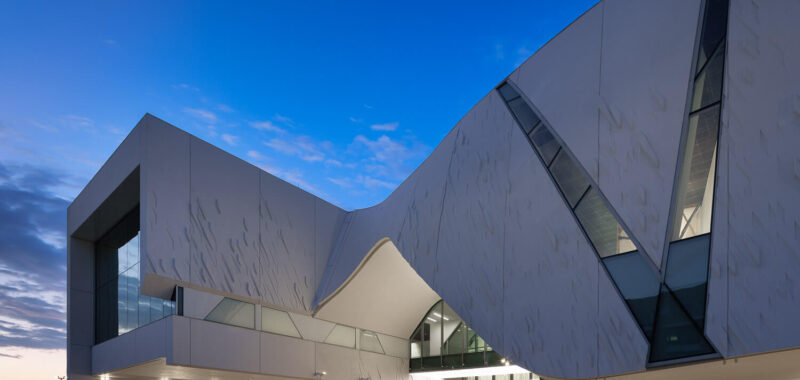- Architect:
- Morphosis
- Location:
- Richardson, Texas
- Completion Date:
- 2024
On the campus of the University of Texas at Dallas, the first phase of the Edith and Peter O’Donnell Jr. Athenaeum, a planned culture and arts district, has opened. Designed by Los Angeles–based architecture firm Morphosis, the building will serve as a satellite location of The Crow Museum of Asian Art, an institution based in Downtown Dallas.
Clad in textured-precast-concrete panels, the Crow Museum’s materiality echoes that of the Perot Museum of Nature and Science, Morphosis’s debut in Dallas which opened in 2012. Both structures are imbued with the firm’s aesthetic signatures—splayed V-columns, dynamic structure, and non-orthogonal forms—while responding to Lone Star State’s hot and sunny climate.

At the Crow, two perpendicular axes of columns lift the building off the ground, creating a shaded loggia that connects to the entrance lobby. Eventually, upon the completion of the remaining two buildings, one arm of the loggia will extend south underneath all three structures, creating a long shaded corridor for students and visitors.

According to a press release, the Crow Museum’s new facility is the first major art museum located in the suburbs north of Dallas proper. The partnership between the two institutions—UT Dallas and the Crow Museum—was originally brokered by Dr. Richard Bretell, founding director of the Edith O’Donnell Institute of Art History at UT Dallas and one-time director of the Dallas Museum of Art.
Bretell passed away prior to the museum’s completion but is posthumously commemorated via the Brettel Reading Room located on the first floor of the structure.

In addition to the collections of the Crow Museum, the new building will also showcase items on loan from the Dallas Museum of Art and other privately-held collections.
These separate exhibition wings are subdivided via a light-filled entrance lobby that rises two stories. Asian art exhibits occupy the large gallery space to the west of the lobby, while items on loan are housed within the smaller cantilevered volume on the other side.

Morphosis was invited to design the museum’s exhibitions—a first for the firm. Eschewing the typical “white cube” approach to gallery space, the architects devised a series of rooms painted in bold-saturated colors, including red, blue, green, and purple, with each corresponding to a segment of the Crow family’s vast collection.
The firm also rebuked the notion that art galleries need to be windowless, incorporating strategically placed spans of glazing across the structure. In part, this is due to the fact that the Crow’s collection is less susceptible to damage from natural light. Comprised of decorative objects made of jade, porcelain, and metal, the items in the collection are less like to fade than, say, an oil painting. Nonetheless, blackout shades are drawn during the day.

Besides the aforementioned use of glass, the Crow Museum is almost entirely built from concrete. Its cladding, structure, and flooring are made from concrete. To approximate the appearance of terrazzo, the upper layer of the floor was ground down, revealing the speckled aggregate beneath.
Explaining the choice of precast concrete for the museum’s exterior, Arne Emerson, partner at Morphosis, told AN: “There is an enormous amount of energy and resources that go into a building. So if you can select materials that are as close as possible to where it’s being built, then it becomes more sustainable… It happens that one of the best architectural pre-casters in the U.S.—Gate Precast—has a plant in Hillsboro, Texas, just two hours south of Dallas.”
In addition to the supplier’s proximity to the site, precast concrete was selected for its durability, cost efficiency, and customizability.

Morphosis’s Perot Museum was clad in plain gray concrete, “like that you’d see on the sidewalk,” Emerson added. To achieve a distinct appearance for the Crow, a white-colored mix was specified.
The firm worked with the manufacturer to add silica sand particles to the mixture, creating a shimmering effect when sunlight hits. Shadow is also important to the appearance of the facade. A pattern of 3D projections and reliefs were applied across the surface of the panels. The forms produce complex silhouettes during the day.

The Edith and Peter O’Donnell Jr. Athenaeum is sited along University Parkway, UT Dallas’s main vehicular entrance. This placement is no accident. Morphosis’s stylized architecture signals the school’s growing ambition to visitors. In addition to the Athenaeum, the school is building a new gaming and esports center, student union, business school, and Dallas Area Rapid Transit (DART) station that will connect to the new Silver Line, an expansion of the city’s extant light rail system.

Subsequent phases of the Athenaeum, all of which are designed by Morphosis, will add a performance hall, additional museum, and parking garage to the site. The opening of the Crow Museum coincided with ground breaking for the performance venue, which is expected to complete construction in 2026.

